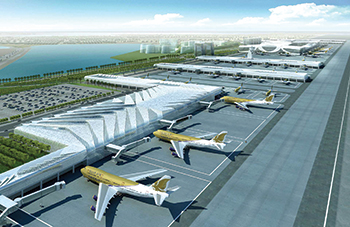Second airport on Bahrain ‘wish list’
01 July 2019
Bahrain is planning to potentially have a second airport within the next 15 years for better connectivity, reported the Gulf Daily News, our sister publication.
The new airport, which could be operational by 2034, is part of a “wish list” for Bahrain’s future growth, stated the report, citing Transportation and Telecommunications Minister Kamal Ahmed.
He said the idea was to start construction work by at least 2030, however no further details about the planned location or infrastructure were revealed.
“The current airport (after the modernisation project) has limitations and by 2030, if we succeed in making Bahrain a thriving country, increasing the growth and development, then by 2034 we should be ready with the new airport.
“I hope that in 2030 we start construction work on the second airport or at least start the process,” he said.
The Gulf Daily News had reported in 2014 that the government had announced Fasht Al Jarim, off the northern coast of Bahrain, as the site for the proposed new airport. However, opponents had said if the plan went ahead it could destroy more than half of the country’s fisheries.
Bahrain International Airport (BIA), located in Muharraq, is currently undergoing a modernisation programme with a new terminal scheduled to be opened in October.
The $1.1-billion expansion is being financed by the Abu Dhabi Fund for Development as part of a GCC financial assistance package pledged to Bahrain in 2011.
The new 207,000-sq-m terminal building will include a 4,600-sq-m departure hall, 104 check-in counters, 36 passport control booths and 24 security screening points.
It is four times the size of the existing terminal and will be able to accommodate 14 million passengers a year.
Meanwhile, work on the proposed 25-km King Hamad Causeway, which will be the second causeway linking Bahrain and Saudi Arabia, is set to begin next year and will cost $4 billion, featuring four lanes for vehicles and two lanes for Bahrain’s monorail network, which will be connected to the GCC Railway.
The project will run parallel to the existing King Fahad Causeway, accommodating passenger trains, freight trains and road vehicles.
- Bahrain plans biggest water sports facility
- Khazaen city masterplan to be ready soon
- Chevron Phillips, QP to build key ethylene plant
- Egypt marks progress on new admin capital
- Investment Gateway makes headway
- Bahrain highway expansion signed off
- New sports medicine hospital planned
- Sohar’s new $1bn power plant starts operation
- Wood wins Duqm petchem Feed deal
- Second airport on Bahrain ‘wish list’
- SSH-designed stem cell centre opens in Kuwait
- Vital Seef-Salman Town power line launched
- Work begins on maternity hospital
- Sohar plans four petchem projects
- PDO-Chinese JV launches first polymer plant
- In brief



